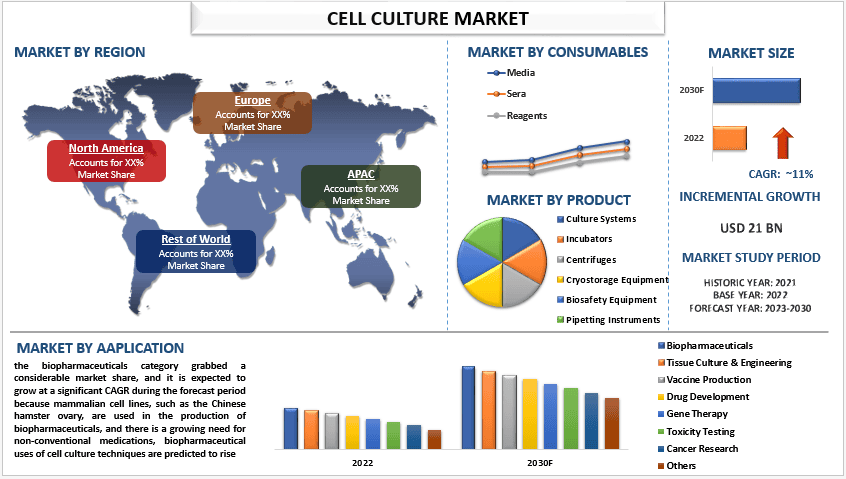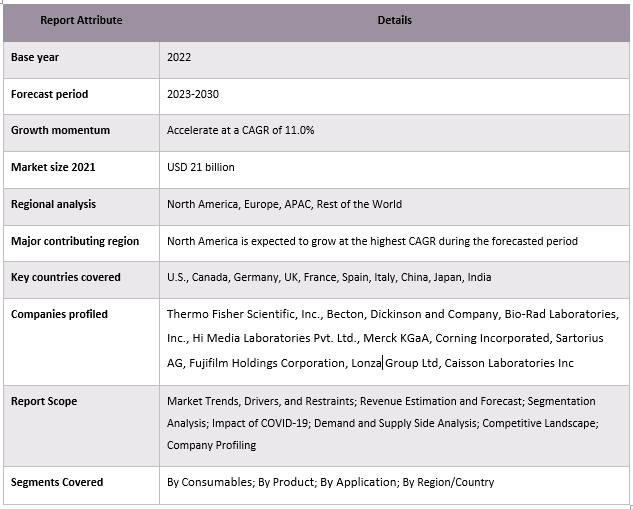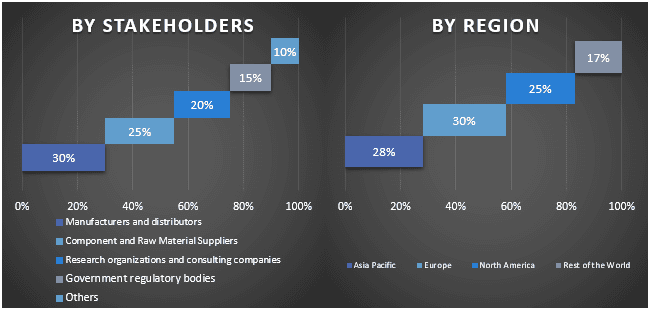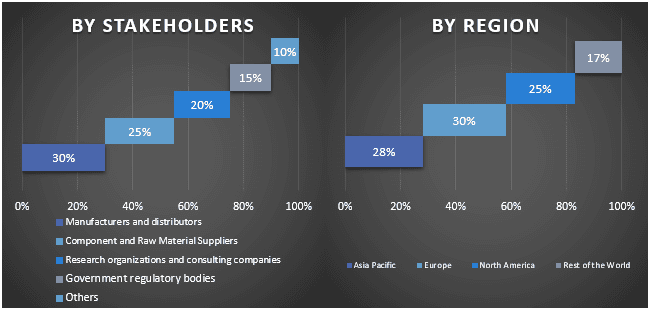Emphasis on Consumables (Media [Minimum Essential Media (MEM), RPMI 1640 Media, DMEM/F-12 Media, F-10 Serum Free Media, BME Media, Other Media], Sera [Fetal Bovine Serum, Other Animal Serum], Reagents [Albumin, Other]); Product (Culture Systems, Incubators, Centrifuges, Cryostorage Equipment, Biosafety Equipment, Pipetting Instruments); Application (Biopharmaceuticals, Tissue Culture & Engineering, Vaccine Production, Drug Development, Gene Therapy, Toxicity Testing, Cancer Research, Others); and Region/Country

The Cell culture market was valued at USD 21 billion in 2022 & is expected to grow at a CAGR of 11% from 2023-2030 The cell culture market refers to the industry involved in the production, maintenance, and utilization of living cells, tissues, or organs in an artificial environment. Cell culture involves the growth and multiplication of cells outside their natural environment, typically in a laboratory setting. These cultured cells are used in various research, biopharmaceutical, and biotechnology applications. Cell culture is a fundamental technique in biomedical research, allowing scientists to study the behavior, characteristics, and functions of cells in a controlled environment. It plays a crucial role in the development of new drugs, vaccines, and therapies, as well as in understanding the mechanisms of diseases and discovering potential treatments. The growing demand for cell culture can be attributed to the rise in the number of cancer research projects and the broadening scope of applications for gene therapies are the key factors that boost the adoption of inorganic growth strategies among key industry players around the globe. For instance, in January 2022, Cytiva (Danaher Corporation) collaborated with Nucleus Biologics for the development of custom culture media for cell and gene therapies. Owing to the glaring statistics cell culture is being used for a variety of applications across the globe and would contribute to the growth of the market in the forthcoming period as well. Furthermore, the cell culture market is anticipated to grow on account of the demand for biopharmaceuticals, such as monoclonal antibodies, vaccines, and recombinant proteins, is increasing. However, some of the restraints in the market including the contamination risks and complex scale-up processes are impeding the growth of this market all over the world.
Some of the major players operating in the market include Thermo Fisher Scientific, Inc., Becton, Dickinson and Company, Bio-Rad Laboratories, Inc., Hi Media Laboratories Pvt. Ltd., Merck KGaA, Corning Incorporated, Sartorius AG, Fujifilm Holdings Corporation, Lonza Group Ltd. Several M&As along with partnerships have been undertaken by these players to facilitate customers with hi-tech and innovative products/technologies.
Insights Presented in the Report
“Amongst product, the culture systems segment held a significant share of the market in 2021.”
Based on the product, the market is bifurcated into culture systems, incubators, centrifuges, cryostorage equipment, biosafety equipment, and pipetting instruments. Among them, the culture systems segment is expected to grow at a higher CAGR in the market. Three-dimensional (3D) cell culture systems better mimic the in vivo cellular environment compared to traditional two-dimensional (2D) systems. 3D culture systems allow cells to interact more closely, form complex tissue-like structures, and exhibit more physiologically relevant behavior. The increasing demand for more accurate and predictive cell culture models has led to the adoption of 3D culture systems, boosting the market for these technologies.
“Amongst application, the biopharmaceuticals segment held the higher CAGR in the market in 2021.”
Based on the application, the cell culture market has been classified into biopharmaceuticals, tissue culture & engineering, vaccine production, drug development, gene therapy, toxicity testing, cancer research, and others. Among them, the biopharmaceuticals category grabbed a considerable market share, and it is expected to grow at a significant CAGR during the forecast period because mammalian cell lines, such as the Chinese hamster ovary, are used in the production of biopharmaceuticals, and there is a growing need for non-conventional medications, biopharmaceutical uses of cell culture techniques are predicted to rise. Furthermore, the recent discovery of numerous grafting procedures and tailored therapy alternatives has broadened the biopharmaceutical domain’s potential prospects.
“North America dominated the Cell culture market in 2021.”
Cell culture has gained increasing popularity in North America due to various factors. North America has a robust biopharmaceutical industry with numerous biotech and pharmaceutical companies conducting research and development activities. The demand for cell culture products and services is driven by the region’s focus on drug discovery, biologics production, and advancements in precision medicine. For instance, in March 2021, Thermo Fisher Scientific, a leading provider of cell culture products, announced the expansion of its bioproduction capabilities in North America with the opening of a new bioprocessing collaboration center in St. Louis, Missouri. The facility aims to support the development and manufacturing of cell and gene therapies, strengthening the cell culture ecosystem in the region. North America is at the forefront of technological advancements in cell culture, including the development of advanced culture systems, automation, and bioprocessing technologies. The region’s strong focus on innovation drives the adoption of cutting-edge cell culture techniques and products. Moreover, North America is home to renowned research institutions, universities, and academic centers that conduct extensive cell culture research. The presence of these institutions fosters collaborations, knowledge exchange, and the advancement of cell culture techniques and applications.
Cell culture Market Report Coverage

Reasons to buy this report:
Customization Options:
The global Cell culture market can further be customized as per the requirement or any other market segment. Besides this, UMI understands that you may have your own business needs, hence feel free to connect with us to get a report that completely suits your requirements.
1. Market Introduction
2. Research Methodology Or Assumption
3. Market Synopsis
4. Executive Summary
5. Impact Of Covid-19 On The Cell Culture Market
6. Global Cell Culture Market Revenue, 2020-2030f
7. Market Insights By Consumables
8. Market Insights By Product
9. Market Insights By Application
10. Market Insights By Region
11. Cell Culture Market Dynamics
12. Cell Culture Market Opportunities
13. Cell Culture Market Trends & Insights
14. Demand And Supply Side Analysis
15. Value Chain Analysis
16. Pricing Analysis
17. Competitive Scenario
18. Company Profiled
19. Disclaimer
Research Methodology for the Cell Culture Market Analysis (2022-2030)
Analyzing the historical market, estimating the current market, and forecasting the future market of the global Cell culture market were the three major steps undertaken to create and analyze the adoption of Cell culture in major regions globally. Exhaustive secondary research was conducted to collect the historical market numbers and estimate the current market size. Secondly, to validate these insights, numerous findings and assumptions were taken into consideration. Moreover, exhaustive primary interviews were also conducted, with industry experts across the value chain of the global Cell culture market. Post assumption and validation of market numbers through primary interviews, we employed a top-down/bottom-up approach to forecasting the complete market size. Thereafter, market breakdown and data triangulation methods were adopted to estimate and analyze the market size of segments and sub-segments of the industry pertains to. Detailed methodology is explained below:
Analysis of Historical Market Size
Step 1: In-Depth Study of Secondary Sources:
Detail secondary study was conducted to obtain the historical market size of the Cell culture market through company internal sources such as annual reports & financial statements, performance presentations, press releases, etc., and external sources including journals, news & articles, government publications, competitor publications, sector reports, third-party database, and other credible publications.
Step 2: Market Segmentation:
After obtaining the historical market size of the Cell culture market, we conducted a detailed secondary analysis to gather historical market insights and share for different segments & sub-segments for major regions. Major segments are included in the report as consumables, product, and application. Further country-level analyses were conducted to evaluate the overall adoption of testing models in that region.
Step 3: Factor Analysis:
After acquiring the historical market size of different segments and sub-segments, we conducted a detailed factor analysis to estimate the current market size of the Cell culture market. Further, we conducted factor analysis using dependent and independent variables such as consumables, product, and application of the cell culture market. A thorough analysis was conducted for demand and supply-side scenarios considering top partnerships, mergers and acquisitions, business expansion, and product launches in the Cell culture market sector across the globe.
Current Market Size Estimate & Forecast
Current Market Sizing: Based on actionable insights from the above 3 steps, we arrived at the current market size, key players in the global Cell culture market, and market shares of the segments. All the required percentage shares split, and market breakdowns were determined using the above-mentioned secondary approach and were verified through primary interviews.
Estimation & Forecasting: For market estimation and forecast, weights were assigned to different factors including drivers & trends, restraints, and opportunities available for the stakeholders. After analyzing these factors, relevant forecasting techniques i.e., the top-down/bottom-up approach were applied to arrive at the market forecast for 2030 for different segments and sub-segments across the major markets globally. The research methodology adopted to estimate the market size encompasses:
Market Size and Share Validation
Primary Research: In-depth interviews were conducted with the Key Opinion Leaders (KOLs) including Top Level Executives (CXO/VPs, Sales Head, Marketing Head, Operational Head, Regional Head, Country Head, etc.) across major regions. Primary research findings were then summarized, and statistical analysis was performed to prove the stated hypothesis. Inputs from primary research were consolidated with secondary findings, hence turning information into actionable insights.
Split of Primary Participants in Different Regions

Market Engineering
The data triangulation technique was employed to complete the overall market estimation and to arrive at precise statistical numbers for each segment and sub-segment of the global cell culture market. data was split into several segments & sub-segments post studying various parameters and trends in the areas of the consumables, product, and application in the global Cell culture market.
The main objective of the Global Cell culture Market Study
The current & future market trends of the global Cell culture market were pinpointed in the study. Investors can gain strategic insights to base their discretion for investments on the qualitative and quantitative analysis performed in the study. Current and future market trends determined the overall attractiveness of the market at a regional level, providing a platform for the industrial participant to exploit the untapped market to benefit from a first-mover advantage. Other quantitative goals of the studies include:

Customers who bought this item also bought